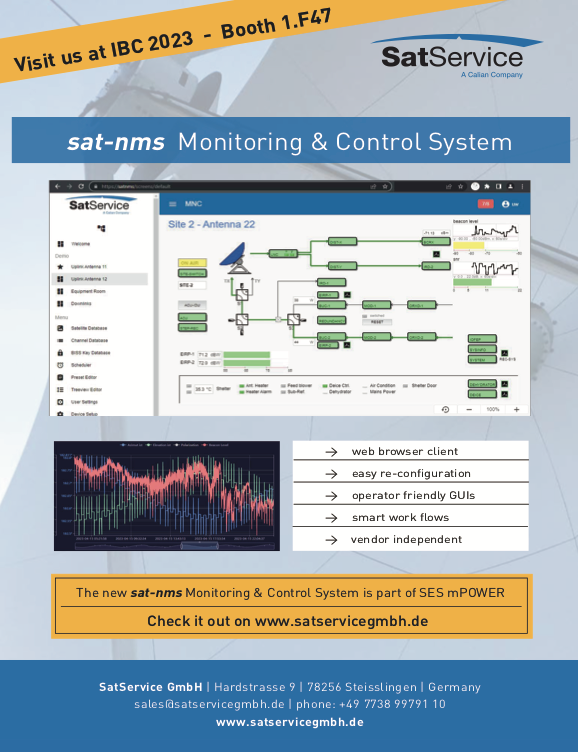Why it will take the SATCOM market by storm
As the global, mobile communication industry eagerly awaits the next connectivity revolution, all eyes are fixed on the goal of providing seamless coverage anywhere on the planet. 5G New Radio NTN is more than likely to become the technology that will lead straight to an efficient and much-desired fusion of terrestrial and non-terrestrial networks.

Much has been said and written about 5G New Radio (5G NR). However, the information is often delivered in contradictory terms as numerous trade media and industry analysts offer their differing opinions on this subject. This tends to muddy the waters and makes it far harder to understand what 5G NR actually is, how it works, what advantages the technology brings to the table, and — perhaps most importantly — how 5G NR will affect mobile communication in the future.
Understanding 5G NR
As most smartphone users are aware, the introduction of 5G gave access to capabilities which were unheard of in earlier generations. But to reach the full potential of 5G mobile networks, a new radio-access technology known as 5G NR has been specified by 3GPP, the standardization organization for mobile telecommunications.
5G NR defines how compatible devices, such as smartphones, IoT-devices and gateways, connect to 5G NR network infrastructure to transmit data wirelessly and also introduces several, major improvements, such as:
Enhanced speed and capacity
5G NR deliver significantly faster data speeds and higher network capacity, enabling ultra-fast downloads, high resolution streaming, and improved overall network performance.
Lower latency
With lower latency, 5G NR delivers near-instantaneous response times, opening doors for real-time applications like autonomous vehicles, remote surgery, and immersive augmented reality experiences.
Improved reliability and coverage
5G NR offer improved reliability, enabling mission-critical applications that demand robust and uninterrupted connectivity.
New and innovative use cases
5G NR unlocks new possibilities for transformative use cases such as smart cities, remote industrial automation, artificial intelligence and augmented reality, revolutionizing industries, and empowering novel applications.
A Serious Business Enabler
For years, satellite communication has been based solely on stand- alone proprietary technology, independent of the standardization efforts driving revenue growth for terrestrial mobile communication. Fortunately, this is about to change.
Soon, 5G NR signals will beam down from space and support terrestrial 5G mobile communication infrastructure. This will give satellites and other non- terrestrial networks a new and highly competitive edge as they become an essential factor in the offering of powerful, seamless connectivity to millions of customers anywhere on the planet.
5G NR also gives non-terrestrial communication companies the opportunity to take advantage of the large-scale economies in the terrestrial industry to lower their cost of user equipment and service prices to more competitive levels.
A New Level Of Interoperability
By unifying 5G standardization of non-terrestrial and terrestrial technology, the barrier between different satellite systems will be eliminated, allowing end users to roam freely between the terrestrial and non-terrestrial networks of various operators.
This will be one of the biggest advantages of 5G NR standardization as it becomes much easier for the terrestrial mobile communication industry to work with satellite operators and other non-terrestrial vendors and provide strong end-to-end service management as all parties are operating on the same 3GPP standard.
The 3GPP 5G NR standardization will allow the non-terrestrial communication industry to reach mass markets due to higher interoperability. The benefit of this is a huge increase in the number of potential customers and an opportunity to tap into a more developed, high-volume supply chain, saving development time and costs.
Where is 5G NR Today?
Most terrestrial network operators currently focus on delivering 5G services to areas currently covered by older, cellular technologies. At the close of 2022, there were 229 commercial 5G terrestrial networks around the world, and the unique capabilities of non-terrestrial networks can drastically expand their reach. This is the reason why there are now numerous public announcements related to the development and testing of 5G services via non-terrestrial networks, especially concerning these types of use cases:
Broadband internet
High-speed, low-latency mobile broadband internet via satellite in remote and rural locations. This is typically accomplished by satellites beaming internet to a dish on the users’ roof, which then passes the signal on to a Wi-Fi router.
Direct-to-smartphone
The first 5G NR-compatible smartphones have already hit the market, and in the coming years, many more will follow. As it is still early days simple services like emergency messaging are the first on offer. But with the advance of 5G NR, new high-speed services will most certainly be launched.
However, just as 5G-technology in terrestrial network needs to evolve from the current roll-out state to the full potential of gigabit speeds and millisecond latencies, non-terrestrial 5G-technology must also follow its own, evolutionary path to complete integration.
Easier Said Than Done
What may be simple to achieve in a terrestrial network can be extremely complicated in a non-terrestrial network. For instance, how do you provide direct-to-smartphone connectivity from a satellite constellation? This is a real challenge due to factors such as access to spectrum, link budgets, high doppler shifts, increase in latency due to interference from terrain, weather, and a range of other factors known to disrupt wireless networks.
The efforts are worth the investment, as the value proposition of a 3GPP standardized, 5G network is crystal clear: non-terrestrial networks can significantly strengthen the 5G experience, where terrestrial networks cannot — particularly regarding mobility and mission-critical communications. By doing so, non-terrestrial networks represent a golden opportunity to extend 5G service coverage of enormously large areas where traditional terrestrial networks have limited reach or cannot operate feasibly.
A Match Made In Heaven

5G NR standardization is by far the most promising opportunity to create new business models involving both the terrestrial and non-terrestrial communications industries.
As non-terrestrial networks will not provide the same capacity as terrestrial systems, they are likely to be viewed as complementary, rather than competing systems. This will undoubtedly lead many companies to join forces in the pursuit of mutual benefits.
There are still technical challenges to overcome before seamless, non-terrestrial and terrestrial network experiences can be achieved, but with the development of 3GPP 5G NR-compliant solutions, huge steps will be taken in the correct direction.
gatehousesatcom.com

Thorleif Astrup Hallund
Thorleif Astrup Hallund has more than 25 years of experience with product and business management in telecommunication companies and tech startups. Currently, he holds the position of Senior Business Development Director at Gatehouse Satcom, spearheading business development with a particular focus on 5G products for non-terrestrial networks. Gatehouse Satcom is a full member of 3GPP and actively contributing to the standardization through extensive knowledge of satellite communication. For further inquiries, please contact Thorleif Astrup Hallund at: [email protected]



